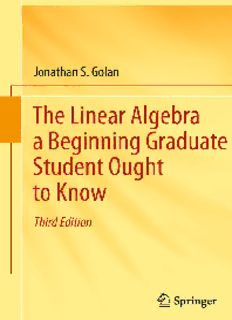
The linear algebra a beginning graduate student ought to know PDF
Preview The linear algebra a beginning graduate student ought to know
The Linear Algebra a Beginning Graduate Student Ought to Know Jonathan S. Golan The Linear Algebra a Beginning Graduate Student Ought to Know Third Edition Prof.JonathanS.Golan Dept.ofMathematics UniversityofHaifa Haifa Israel ISBN978-94-007-2635-2 e-ISBN978-94-007-2636-9 DOI10.1007/978-94-007-2636-9 SpringerDordrechtHeidelbergLondonNewYork LibraryofCongressControlNumber:2012933373 MathematicsSubjectClassification(2010): 15-XX,16-XX,17-XX,65F30 ©SpringerScience+BusinessMediaB.V.2004,2007,2012 Nopartofthisworkmaybereproduced,storedinaretrievalsystem,ortransmittedinanyformorby anymeans,electronic,mechanical,photocopying,microfilming,recordingorotherwise,withoutwritten permissionfromthePublisher,withtheexceptionofanymaterialsuppliedspecificallyforthepurpose ofbeingenteredandexecutedonacomputersystem,forexclusiveusebythepurchaserofthework. Whilstwehavemadeconsiderableeffortstocontactallholdersofcopyrightmaterialcontainedinthis book.Wehavefailedtolocatesomeofthem.ShouldholderswishtocontactthePublisher,wewillmake everyefforttocometosomearrangementwiththem. Printedonacid-freepaper SpringerispartofSpringerScience+BusinessMedia(www.springer.com) To thememoryofHemda,mywifeofover40 years: Andtomygrandchildren: Shachar, Eitan, Sarel, Nachshon, Yarden, Itamar,Roni,and Naomi For Whom Is This Book Written? Crow’sLaw:Donotthinkwhatyouwanttothinkuntilyouknowwhatyou oughttoknow.1 Linearalgebraisa living,activebranchof mathematicalresearch whichis central toalmostallotherareasofmathematicsandwhichhasimportantapplicationsinall branchesofthephysicalandsocialsciencesandinengineering.However,inrecent years the content of linear algebra courses required to complete an undergraduate degreeinmathematics—andevenmoresoinotherareas—atallbutthemostded- icated universities, has been depleted to the extent that it falls far short of what is in fact needed for graduate study and research or for real-world application. This is true not only in the areas of theoretical work but also in the areas of computa- tionalmatrixtheory,whicharebecomingmoreandmoreimportanttotheworking researcher as personal computers become a common and powerful tool. Students arenotonlylessabletoformulateorevenfollowmathematicalproofs,theyarealso lessabletounderstandtheunderlyingmathematicsofthenumericalalgorithmsthey mustuse.Theresultingknowledgegaphasledtofrustrationandrecriminationon the part of both students and faculty alike, with each silently—and sometimes not sosilently—blamingtheotherfortheresultingstateofaffairs.Thisbookiswritten with the intention of bridging that gap. It was designed be used in one or more of severalpossibleways: (1) Asaself-studyguide; (2) Asatextbookforacourseinadvancedlinearalgebra,eitherattheupper-class undergraduateleveloratthefirst-yeargraduatelevel;or (3) Asareferencebook. It is also designed to be used to prepare for the linear algebra portion of prelim examsorPh.D.qualifyingexams. This volume is self-contained to the extent that it does not assume any previ- ousknowledgeofformallinearalgebra,thoughthereaderisassumedtohavebeen exposed,atleastinformally,tosomebasicideasortechniques,suchasmatrixma- nipulationandthesolutionofasmallsystemoflinearequations.Itdoes,however, 1Thislaw,attributedtoJohnCrowofKing’sCollege,London,isquotedbyR.V.Jonesinhisbook MostSecretWar,Wordsworth,1998(ISBN978-1853266997). vii viii ForWhomIsThisBookWritten? assumeaseriousnessofpurpose,considerablemotivation,andmodicumofmathe- maticalsophisticationonthepartofthereader. Thetheoreticalconstructionspresentedhereareillustratedwithalargenumberof examplestakenfromvariousareasofpureandappliedmathematics.Asinanyarea ofmathematics,theoryandconcreteexamplesmustgohandinhandandneedtobe studied together. As the German philosopher Immanuel Kant famously remarked, conceptswithoutpreceptsareempty,whereaspreceptswithoutconceptsareblind. The book also contains a large number of exercises, many of which are quite challenging,whichIhavecomeacrossorthoughtupinoverthirtyyearsofteaching. Many of these exercises have appeared in print before, in such journals as Ameri- can Mathematical Monthly, College Mathematics Journal, Mathematical Gazette, orMathematicsMagazine,invariousmathematicscompetitionsorcirculatedprob- lem collections, or even on the internet. Some were donated to me by colleagues andevenstudents,andsomeoriginatedinfilesofoldexamsatvariousuniversities whichIhavevisitedinthecourseofmycareer.Since,overtheyears,Ididnotkeep trackoftheirsources,allIcandoisofferacollectiveacknowledgementtoallthose towhomitisdue.Goodproblemformulators,liketheGodoftheabbotofCiteaux, knowtheirown.Deliberately,difficultexercisesarenotmarkedwithanasteriskor othersymbol.Solvingexercisesisanintegralpartoflearningmathematicsandthe reader is definitely expected to do so, especially when the book is used for self- study. Try them all and remember the “grook” penned by the Danish genius Piet Hein:Problemsworthyofattack/Provetheirworthbyhittingback. Solving a problem using theoretical mathematics is often very different from solvingitcomputationally,andsostrongemphasisisplacedontheinterplayofthe- oretical and computational results. Real-life implementation of theoretical results isperpetuallyplaguedbyerrors: errors inmodeling,errors indataacquisitionand recording,and errors in thecomputationalprocess itself due toroundoff andtrun- cation. There are further constraints imposed by limitations in time and memory availableforcomputation.Thusthemosteleganttheoreticalsolutiontoaproblem maynotleadtothemostefficientorusefulmethodofsolutioninpractice.Whileno referenceismadetoparticularcomputersoftware,theconcurrentuseofapersonal computerequippedsymbolic-manipulationsoftwaresuchasMAPLE,MATHEMAT- ICA,MATLAB,orMUPADisdefinitelyadvised. In order to show the “human face” of mathematics, the book also includes a largenumberofthumbnailphotographsofresearcherswhohavecontributedtothe developmentofthematerialpresentedinthisvolume. Acknowledgements Most of the first edition this book was written while I was avisitorattheUniversityofIowainIowaCityandattheUniversityofCalifornia inBerkeley.Iwouldliketothankbothinstitutionsforprovidingthefacilitiesand, more importantly, the mathematical atmosphere which allowed me to concentrate on writing. Subsequent, extensively revised editions, were prepared after I retired fromteachingattheUniversityofHaifainApril,2004. Ihavetalkedtomanystudentsandfacultymembersaboutmyplansforthisbook and have obtained valuable insights from them. In particular, I would like to ac- knowledgetheaidofthefollowingcolleaguesandstudentswhowerekindenough ForWhomIsThisBookWritten? ix toreadthepreliminaryversionsofthisbookandoffertheircommentsandcorrec- tions: Prof. Daniel Anderson (University of Iowa), Prof. Adi Ben-Israel (Rutgers University),Prof.RobertCacioppo(TrumanStateUniversity),Prof.JosephFelsen- stein (University of Washington), Prof. Ryan Skip Garibaldi (Emory University), Mr.GeorgeKirkup(UniversityofCalifornia,Berkeley),Dr.DenisSevee(JohnAl- bert College), Prof. Earl Taft (Rutgers University), Mr. Gil Vernik (University of Haifa). Haifa,Israel JonathanS.Golan
Description: